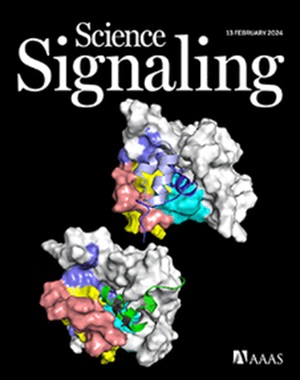细胞内和核内的CXCR4信号传导促进终端红母细胞分化和去核
IF 6.6
1区 生物学
Q1 BIOCHEMISTRY & MOLECULAR BIOLOGY
引用次数: 0
摘要
趋化因子CXCL12通过其受体CXCR4发出信号,诱导所有白细胞类型和多种其他细胞类型的迁移。在这里,我们报道了CXCR4在小鼠红细胞(骨髓红细胞前体)中表达,它刺激红细胞生成而不是趋化性。CXCR4信号传导促进了稳态红母细胞成熟,增加了主要参与代谢和染色质组织的基因的表达。因此,红细胞中CXCR4的基因缺失抑制了晚期红细胞生成和骨髓红细胞输出的减少。CXCL12与CXCR4的结合刺激其快速内吞和易位,与Gαi或磷酸化的β-arrestin1一起进入不同的细胞内室,包括核膜和细胞核。CXCL12信号传导促进了红母细胞的伸长和细胞核的凝聚和向外定位,并刺激了红母细胞去核前的快速核周Ca2+瞬态。这些发现强调了CXCR4和骨髓来源的CXCL12在红细胞生成中的先前未被描述的生理作用。本文章由计算机程序翻译,如有差异,请以英文原文为准。
Intracellular and nuclear CXCR4 signaling promotes terminal erythroblast differentiation and enucleation
The chemokine CXCL12 signals through its receptor CXCR4 to induce the migration of all leukocyte types and multiple other cell types. Here, we report that CXCR4 is expressed in mouse erythroblasts, the bone marrow erythroid precursors, in which it stimulates erythrocyte generation instead of chemotaxis. CXCR4 signaling promoted homeostatic erythroblast maturation and increased the expression of genes mainly involved in metabolism and chromatin organization. Consequently, genetic depletion of CXCR4 in erythroblasts inhibited late erythropoiesis and diminished bone marrow erythroid outputs. Binding of CXCL12 to CXCR4 stimulated its rapid endocytosis and translocation together with Gαi or phosphorylated β-arrestin1 into distinct intracellular compartments, including the nuclear envelope and nucleus. CXCL12 signaling promoted erythroblast elongation and the condensation and excentric positioning of nuclei and stimulated rapid perinuclear Ca2+ transients that immediately preceded erythroblast enucleation. These findings highlight previously uncharacterized physiological roles for CXCR4 and bone marrow–derived CXCL12 in erythropoiesis.
求助全文
通过发布文献求助,成功后即可免费获取论文全文。
去求助
来源期刊

Science Signaling
BIOCHEMISTRY & MOLECULAR BIOLOGY-CELL BIOLOGY
CiteScore
9.50
自引率
0.00%
发文量
148
审稿时长
3-8 weeks
期刊介绍:
"Science Signaling" is a reputable, peer-reviewed journal dedicated to the exploration of cell communication mechanisms, offering a comprehensive view of the intricate processes that govern cellular regulation. This journal, published weekly online by the American Association for the Advancement of Science (AAAS), is a go-to resource for the latest research in cell signaling and its various facets.
The journal's scope encompasses a broad range of topics, including the study of signaling networks, synthetic biology, systems biology, and the application of these findings in drug discovery. It also delves into the computational and modeling aspects of regulatory pathways, providing insights into how cells communicate and respond to their environment.
In addition to publishing full-length articles that report on groundbreaking research, "Science Signaling" also features reviews that synthesize current knowledge in the field, focus articles that highlight specific areas of interest, and editor-written highlights that draw attention to particularly significant studies. This mix of content ensures that the journal serves as a valuable resource for both researchers and professionals looking to stay abreast of the latest advancements in cell communication science.
 求助内容:
求助内容: 应助结果提醒方式:
应助结果提醒方式:


